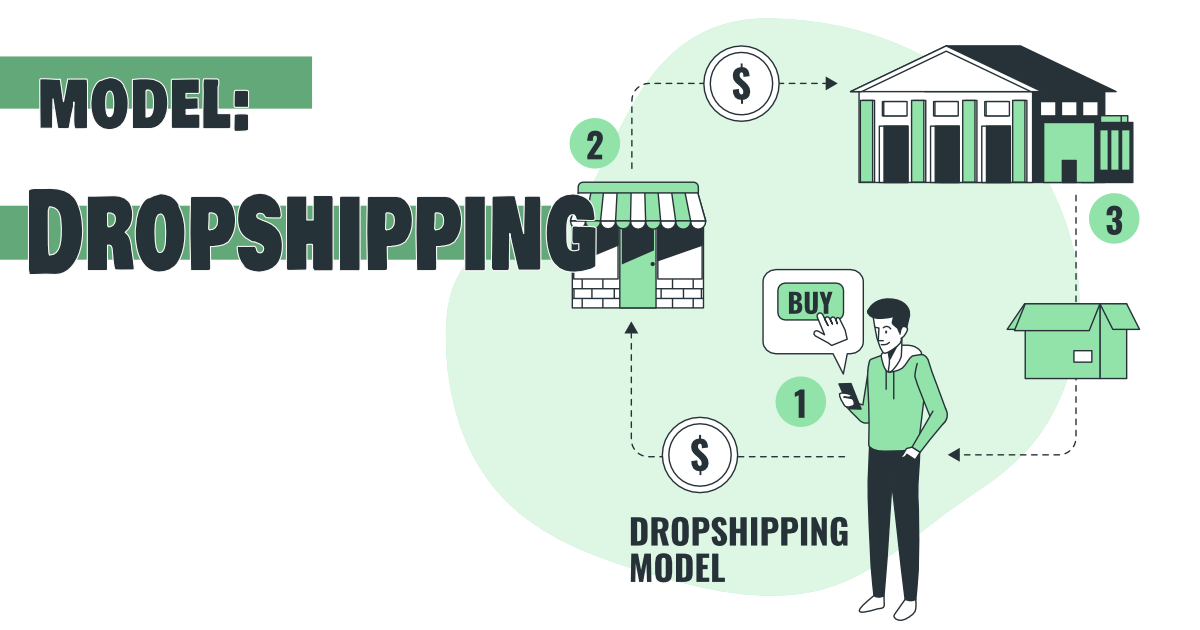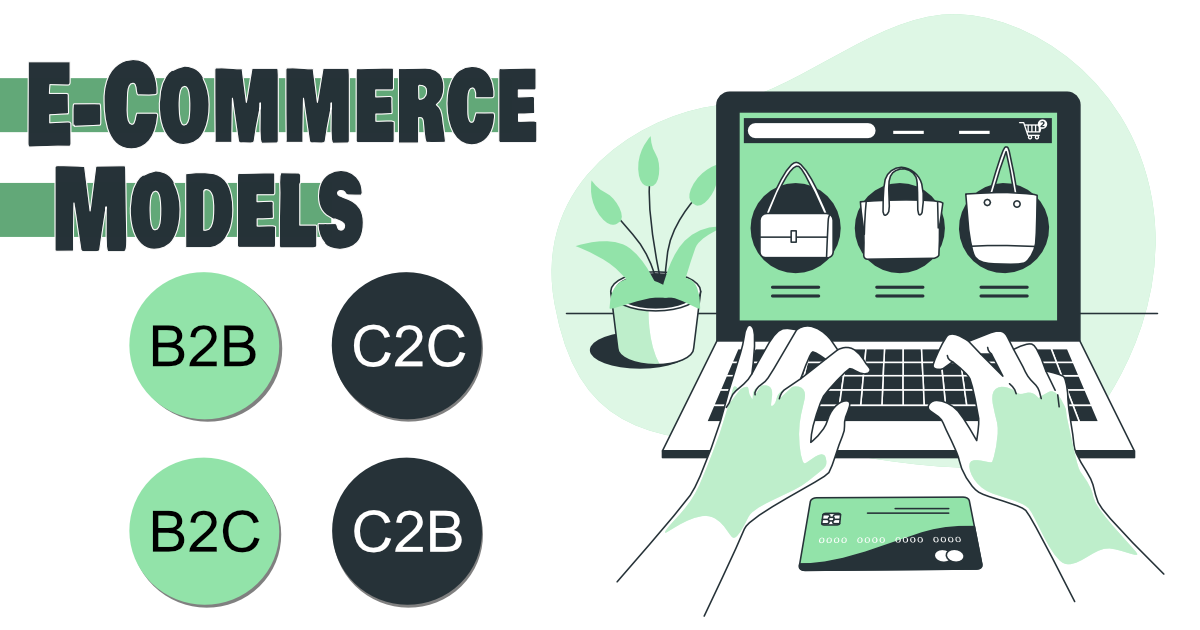The dropshipping model is a retail fulfillment method where a store doesn’t keep the products it sells in stock. Instead, when a store sells a product, it purchases the item from a third-party supplier and has it shipped directly to the customer. This allows the store to offer a wide range of products without having to manage inventory or fulfill orders themselves. The dropshipping model is popular among online retailers and has become increasingly prevalent with the growth of e-commerce.
Overview of dropshipping model
In this model, the store acts as a middleman between the customer and supplier. The store is responsible for marketing and selling the product, while the supplier handles the storage, packing, and shipping of the product.
The following are the steps involved in the dropshipping model:
- Identifying the market: The first step in starting a dropshipping business is to identify a market segment and determine if there is a demand for the products you want to sell.
- Finding a supplier: The next step is to find a reputable supplier who can provide you with the products you want to sell. You can use platforms like Alibaba, SaleHoo, or Doba to find suppliers.
- Setting up an online store: Once you have found a supplier, you will need to set up an online store to sell your products. You can use platforms like Shopify, WooCommerce, or Magento to set up your store.
- Marketing and advertising: Once your store is set up, you need to start marketing and advertising your products to reach potential customers. You can use various marketing strategies, including search engine optimization (SEO), pay-per-click (PPC) advertising, and social media marketing.
- Processing orders: When a customer places an order, you purchase the product from your supplier and have it shipped directly to the customer. You keep the difference between the price you charged the customer and the price you paid the supplier.
- Customer service and support: You are responsible for providing excellent customer service and support to your customers. This includes answering customer inquiries, handling returns, and resolving any issues that may arise.
- Data analysis and optimization: To ensure the success of your dropshipping business, it’s important to regularly analyze your sales data and make adjustments to your marketing and advertising strategies to optimize your results.
In conclusion, the dropshipping model is a low-risk and low-cost way to start an online retail business. It offers the flexibility to sell a wide range of products without the need for a physical inventory. However, it is important to do thorough research and choose a reputable supplier, provide excellent customer service, and regularly optimize your strategies to ensure the success of your dropshipping business.
Types of products offered
In a dropshipping model, the types of products offered can vary greatly. From clothing and accessories, to electronics, to home goods and beyond, the options are endless. One of the main benefits of a dropshipping model is that it allows for a wide range of products to be offered without having to hold any physical inventory.
When choosing the products to offer in a dropshipping model, it’s important to consider a number of factors. These may include:
- Popularity: What are customers interested in and what is selling well in the market currently?
- Competition: What products are already being sold by other dropshipping businesses and how can you differentiate your offerings?
- Profit margins: How much money can you make per product sold?
- Shipping costs: Some products may be bulky or heavy, which could increase shipping costs and reduce profitability.
- Intellectual property rights: Ensure that the products being sold do not infringe on any patents, trademarks, or copyrights.
To determine the best products to offer in a dropshipping model, it is important to research the market and competition, test different product offerings, and track sales and profits.
When it comes to choosing the right product for your dropshipping business, there are a few best practices to keep in mind:
- Focus on niche products: By specializing in a specific type of product, you can differentiate your business and offer unique products to your customers.
- Test and iterate: Start with a small number of products and test their performance. As you learn what sells well, you can expand your product line.
- Monitor trends: Keep up-to-date on market trends and be ready to pivot your product offerings as needed.
In conclusion, choosing the right products to offer in a dropshipping model is a critical factor in the success of the business. By researching the market, testing different product offerings, and focusing on niche products, you can increase your chances of success.
Supplier selection and management
Supplier selection and management is a critical component of the dropshipping model. It is important to choose the right supplier, who is reliable, trustworthy, and has a proven track record of delivering quality products on time. The following are the steps involved in the process of supplier selection and management:
- Identify your product niche: Determine the type of products you want to sell, and the target audience. This will help you narrow down your search for the right supplier.
- Research potential suppliers: Use online marketplaces, trade shows, and industry forums to find potential suppliers. Look for suppliers who have experience with the products you want to sell and a good reputation in the industry.
- Evaluate the quality of products: Check the quality of the products offered by the supplier. Ask for samples, read reviews and ratings, and compare prices.
- Assess the supplier’s reliability: Look for suppliers who have a proven track record of delivering products on time, and who are responsive to customer inquiries and complaints.
- Negotiate terms and conditions: Once you have selected a supplier, it is important to negotiate the terms and conditions of the agreement. This includes product prices, shipping times, payment terms, and return policies.
- Establish a strong working relationship: Maintain open and transparent communication with your supplier, and establish clear expectations and responsibilities. This will help ensure a smooth and successful working relationship.
- Monitor supplier performance: Regularly monitor the supplier’s performance, and address any issues or concerns as they arise. This will help ensure that the supplier continues to meet your expectations.
Some popular suppliers in the dropshipping market
- AliExpress – AliExpress is a Chinese e-commerce platform that offers a wide variety of products, including electronics, fashion, beauty products, and home goods. They have a large number of suppliers and offer competitive prices, making them a popular choice for dropshipping.
- Oberlo – Oberlo is a Shopify app that connects with AliExpress to help you find and manage your dropshipping products. They offer a wide variety of products, including electronics, fashion, and beauty products.
- Banggood – Banggood is another Chinese e-commerce platform that offers a wide range of products, including electronics, fashion, and beauty products. They have a strong reputation for quality products and fast shipping.
- Spocket – Spocket is a dropshipping platform that focuses on providing high-quality, unique products from suppliers located in the US and EU. They offer a wide range of products, including clothing, home goods, and pet products.
- Wholesale2B – Wholesale2B is a dropshipping platform that offers a wide variety of products from suppliers around the world. They offer an easy-to-use platform for managing your orders and product listings, as well as a suite of tools for analyzing your sales and customer data.
- SaleHoo – SaleHoo is a wholesale supplier directory that provides access to over 8,000 vetted wholesale suppliers and over 1.6 million products. It’s a popular platform for dropshippers because of its extensive list of suppliers and affordable membership fees.
- Doba – Doba is a dropshipping platform that connects online retailers with suppliers, providing access to over 2 million products across hundreds of categories. They handle the sourcing, storage, and shipment of products, making it easy for online retailers to manage their business.
- Modalyst – Modalyst is a platform that offers dropshipping services to online retailers. They offer access to over 60,000 products from suppliers around the world, and their platform is user-friendly, making it easy for online retailers to manage their business.
- Dropship Me – Dropship Me is a WordPress plugin that provides access to over 50,000 handpicked products that are pre-loaded into your store. They take care of product data, descriptions, and images, making it easy for online retailers to focus on marketing and sales.
- Sunrise Wholesale – Sunrise Wholesale is a wholesale dropshipper that provides access to over 15,000 products in a variety of categories. They offer flexible pricing options and a user-friendly platform, making it easy for online retailers to manage their business.
These are just a few of the many suppliers available for dropshipping. It is important to thoroughly research and vet each supplier to ensure they provide quality products and customer service, and to determine if they are a good fit for your business.
Best practices for supplier selection and management in the dropshipping model include having a clear and concise agreement, regularly communicating with your supplier, and keeping detailed records of all transactions. Additionally, it is important to be flexible and adaptable to changes in the market and to the supplier’s needs.
Examples of successful dropshipping businesses include AliExpress, Amazon, and eBay, which all have extensive networks of suppliers and a proven track record of success.
To become a successful dropshipper, it is important to have a solid understanding of the dropshipping model, including supplier selection and management.
In conclusion, supplier selection and management is a critical aspect of the dropshipping model. By following the steps outlined above, and incorporating best practices, you can build a successful and profitable dropshipping business.
Customer demographics
Customer demographics refer to the characteristics and traits of a target audience or customer base, such as age, income, education, location, and purchasing habits. Understanding customer demographics is crucial in the dropshipping model as it helps businesses to identify the right target market and create marketing strategies that resonate with them.
Steps to Analyze Customer Demographics
- Identify the target market: Determine who the ideal customer is for the product(s) you plan to sell.
- Gather data: Collect data on your target audience, including age, gender, location, income, education, and purchasing habits.
- Analyze the data: Use tools such as market research reports, surveys, and customer feedback to analyze the data and better understand your target audience.
- Segment the market: Divide the target market into smaller groups based on their shared characteristics.
- Create personas: Create a detailed profile of each segment of the target market, including their needs, preferences, and pain points.
Why is Customer Demographics Important in Dropshipping Model?
- Product selection: By understanding the customer demographics, businesses can choose products that are more likely to appeal to their target audience.
- Marketing strategies: Businesses can create targeted marketing campaigns that resonate with their target audience and increase the chances of making a sale.
- Customer satisfaction: By understanding the needs and preferences of the target audience, businesses can provide better customer service and increase customer satisfaction.
How to Use Customer Demographics in Dropshipping Model?
- Personalized marketing: Create targeted marketing campaigns based on the customer demographics, such as email marketing, social media advertising, and influencer marketing.
- Product development: Consider the needs and preferences of the target audience when developing new products or improving existing ones.
- Customer support: Provide customer support that is tailored to the needs of the target audience, such as offering multiple language options and extended hours of support.
Relevant Examples
- A dropshipping business that sells fitness products may target customers who are fitness enthusiasts and have a higher income. The business may use social media platforms such as Instagram and Facebook to reach this target audience and create targeted marketing campaigns.
- A dropshipping business that sells baby products may target new parents and expectant mothers. The business may use targeted advertising on parenting websites and forums to reach this target audience.
Best Practices
- Regularly update customer demographics data: Regularly gather and analyze data on the target audience to ensure that the customer demographics data is up-to-date.
- Use multiple data sources: Use multiple data sources, such as surveys, customer feedback, and market research reports, to gather a more complete picture of the target audience.
- Segment the target audience: Segment the target audience into smaller groups based on their shared characteristics to create more effective marketing campaigns.
Actionable Tips
- Ask for customer feedback: Encourage customers to provide feedback on their experience with the business, including their needs and preferences.
- Analyze website traffic: Use tools such as Google Analytics to analyze website traffic and gather information on the target audience, such as age, location, and purchasing habits.
- Use social media listening tools: Use social media listening tools to monitor customer conversations and gather insights into their needs and preferences.
In conclusion, understanding customer demographics is a crucial aspect of running a successful dropshipping business. By understanding your target audience, you can make informed decisions about what products to offer, how to market them, and how to provide the best customer service and support. To gather information about customer demographics, you can use various tools such as Google Analytics, surveys, and customer feedback. You can also analyze data from your website or social media channels to learn more about your customers and their preferences. By continually gathering and analyzing this data, you can stay up-to-date on the evolving needs and preferences of your target audience, and make any necessary adjustments to your dropshipping model to ensure ongoing success.
Marketing and advertising strategies
Marketing and advertising strategies play a crucial role in the success of a dropshipping business. The goal of these strategies is to attract potential customers and build brand awareness, ultimately leading to increased sales. In order to effectively market and advertise a dropshipping business, it is important to understand the target customer demographic and choose the right channels to reach them.
Steps in Marketing and Advertising Strategies for Dropshipping
- Define target customer demographic: Understanding the target customer demographic is crucial in determining the most effective marketing and advertising strategies. This can be done by analyzing data such as age, gender, location, and purchasing habits.
- Choose the right channels: There are numerous channels available for marketing and advertising, including social media, email marketing, influencer marketing, and search engine optimization (SEO). Choosing the right channels for a dropshipping business will depend on the target customer demographic and the type of products being sold.
- Develop a marketing plan: A marketing plan should include a detailed outline of the marketing and advertising strategies to be implemented, as well as a budget and timeline for execution. This plan should also include metrics for measuring success, such as website traffic and sales.
- Utilize social media: Social media is a powerful tool for marketing and advertising, as it allows a business to reach a large audience with minimal cost. Platforms such as Facebook, Instagram, and Twitter can be used to promote products and engage with customers.
- Implement email marketing: Email marketing is an effective way to reach potential customers and keep current ones engaged. This can be done by sending regular newsletters or promotional emails, offering discounts and special promotions.
- Utilize influencer marketing: Influencer marketing involves partnering with influencers in the same niche as the dropshipping business to promote products. Influencers have a large following and can be a valuable asset in promoting a business.
- Optimize for search engines: SEO is the process of optimizing a website to rank higher in search engine results pages (SERPs). This can be done by including keywords in product descriptions and website content, as well as utilizing backlinks from other reputable websites.
Best Practices
- Continuously analyze and adjust strategies: The effectiveness of marketing and advertising strategies should be continuously monitored and adjusted as needed.
- Personalize promotions: Personalized promotions and offers can be a powerful tool in attracting and retaining customers.
- Utilize customer feedback: Listening to customer feedback and making changes based on their feedback can greatly improve the effectiveness of marketing and advertising strategies.
Actionable Tips
- Offer incentives for customers to share products on social media, such as discounts or exclusive promotions.
- Partner with other businesses in the same niche to cross-promote each other’s products.
- Utilize user-generated content, such as product reviews and customer photos, in marketing and advertising materials.
In conclusion, marketing and advertising strategies are essential for the success of a dropshipping business. By understanding the target customer demographic, choosing the right channels, and implementing effective strategies, a dropshipping business can attract potential customers, build brand awareness, and increase sales. Continuously analyzing and adjusting strategies, utilizing customer feedback, and implementing personalized promotions can also greatly improve the effectiveness of marketing and advertising efforts.
Payment and delivery options
Payment and delivery options are a crucial aspect of any e-commerce business. They not only impact the customer’s purchasing experience but also affect the business’s revenue and customer loyalty.
The process of payment and delivery options starts with an understanding of the target market’s preferences and behaviors. This includes the types of payment methods they use, the delivery options they expect, and the speed and cost of delivery they prefer.
Based on this understanding, e-commerce businesses must choose the payment and delivery options that best align with their customers’ preferences and needs.
Why? Because customers are more likely to make a purchase if they are offered payment and delivery options that they trust and prefer.
For example, a business targeting young tech-savvy customers should offer payment options such as mobile payments and digital wallets, whereas a business targeting an older demographic may need to offer traditional payment options such as credit card and cash on delivery.
When it comes to delivery options, businesses must consider factors such as the speed and cost of delivery, shipping fees, and the ability to track deliveries. A business targeting customers who prioritize speed may need to offer express delivery options, whereas a business targeting price-sensitive customers may need to offer more cost-effective delivery options.
Best Practices
- Offer a variety of payment methods to cater to different customer preferences
- Ensure that payment methods are secure and trustworthy
- Offer transparent shipping fees and delivery options
- Provide real-time delivery tracking for customers
- Continuously monitor and improve delivery times and costs
Commonly used payment and delivery methods
- Online payments – Credit/debit cards, PayPal, and other digital payment methods that allow customers to pay for their orders online.
- Cash on delivery (COD) – Customers pay for their orders upon receipt, providing a convenient and secure payment method for those who prefer not to use online payments.
- Bank transfers – Customers can transfer payment directly to the supplier’s bank account, often used for larger purchases.
- Delivery options – Standard shipping, expedited shipping, and international shipping are the most common delivery options offered. Some suppliers also offer free shipping for orders over a certain amount.
- Third-party shipping and payment – Using a third-party platform for shipping and payment can simplify the process for both the supplier and the customer, and can also provide added security for sensitive information.
Actionable Tips
- Consider using a payment gateway or a payment processor to handle payments securely
- Partner with a reliable delivery service provider to ensure timely and cost-effective deliveries
- Offer promotions and discounts on shipping fees to incentivize customers to make a purchase
In conclusion, payment and delivery options are a critical aspect of any e-commerce business. By understanding the target market’s preferences and choosing payment and delivery options that cater to those preferences, businesses can improve the customer’s purchasing experience and increase revenue and customer loyalty.
Customer service and support
Customer service and support are crucial components of a successful dropshipping business. By providing excellent customer service and support, you can build trust and loyalty with your customers, which is key to retaining them and growing your business.
Steps involved in delivering effective customer service and support in the dropshipping model:
- Define your customer service goals: Decide what you want to achieve through customer service, such as reducing churn rate, increasing customer satisfaction, or resolving issues quickly.
- Choose the right channels: Offer multiple channels for customers to reach you, such as email, live chat, phone, and social media. Choose the channels that are most relevant to your target audience and convenient for them to use.
- Train your customer service team: Train your customer service team on product knowledge, problem-solving techniques, and communication skills. Provide them with the tools and resources they need to resolve customer issues effectively.
- Respond promptly: Respond to customer inquiries and issues as soon as possible, within 24 hours if possible. This shows that you value their time and are committed to resolving their issues.
- Use a customer relationship management (CRM) system: Use a CRM system to track customer interactions, manage customer data, and improve your customer service process.
- Implement a customer feedback system: Encourage customers to provide feedback on their experience with your customer service and support. This feedback can be used to identify areas for improvement and make changes to better serve your customers.
Best Practices
- Personalizing the customer experience
- Providing clear and concise communication
- Listening to customer feedback and making improvements
- Maintaining transparency about the dropshipping process
Examples of companies that have effectively implemented customer service and support in their dropshipping model include Zenni Optical, Dollar Shave Club, and Brooklinen.
Actionable Tips
- Offering live chat support
- Providing clear and detailed product information on your website
- Offering free returns and exchanges
- Providing tracking information for deliveries
- Having a comprehensive FAQ section on your website
In conclusion, customer service and support play a critical role in the success of a dropshipping business. By providing excellent customer service and support, you can build trust and loyalty with your customers, reduce churn rate, and grow your business.
Inventory management
Inventory management is a critical aspect of any business, including dropshipping. It involves tracking, organizing and managing the flow of products from suppliers to customers. The goal of inventory management is to ensure that a business always has the right amount of products in stock to meet customer demand, without overstocking or running out of stock. This helps to avoid lost sales, customer dissatisfaction, and missed opportunities.
The process of inventory management in the dropshipping model typically involves the following steps:
- Determine demand: The first step in inventory management is to determine the demand for the products you offer. This can be done using a variety of methods, including market research, customer feedback, and sales data analysis.
- Identify suppliers: Once you know the demand for your products, you can identify potential suppliers who can provide the products you need. Consider factors such as product quality, delivery time, and price when making your selection.
- Negotiate terms: Once you have identified potential suppliers, you can negotiate the terms of your relationship, including price, payment terms, and delivery time.
- Monitor stock levels: Continuously monitor your stock levels to ensure that you always have enough products to meet customer demand. You can use tools such as automated inventory management systems to help you track stock levels in real-time.
- Reorder products: When your stock levels reach a certain threshold, it’s time to reorder products from your supplier. Ensure that you place your order in time to avoid running out of stock and losing sales.
- Manage returns: Another important aspect of inventory management is managing returns. This involves receiving, inspecting, and processing returns from customers, and restocking the products where necessary.
Best Practices
- Regularly reviewing and updating your product catalog to ensure that it accurately reflects the products you offer.
- Building relationships with suppliers to ensure that you have a reliable source of products and that your suppliers are responsive to your needs.
- Automating your inventory management processes to improve accuracy and efficiency.
Actionable Tips
- Develop a detailed plan for managing your inventory, including how you will track and manage stock levels.
- Regularly review your inventory management processes to identify areas for improvement.
- Consider using tools such as inventory management software and automated systems to help you manage your inventory more effectively.
In conclusion, inventory management is a critical aspect of the dropshipping model, and it requires careful planning, monitoring, and management to be successful. By following best practices and using tools and systems to help manage your inventory, you can improve your chances of success and grow your dropshipping business over time.
Data analysis and optimization
Data analysis and optimization are crucial components of the dropshipping model. In this model, merchants do not physically hold inventory and rely on suppliers to fulfill orders. This means that they must carefully manage their data to ensure they are making informed decisions. The goal of data analysis and optimization is to maximize sales, minimize costs, and improve customer satisfaction. Here are the steps involved in the process of data analysis and optimization in the dropshipping model:
- Data Collection: The first step in data analysis is to collect data from various sources such as e-commerce platforms, customer feedback, sales reports, and other relevant sources.
- Data Cleaning: The collected data must be cleaned and organized to remove any inconsistencies or errors. This will ensure that the data is ready for analysis.
- Data Analysis: Using data analysis tools and techniques, merchants can gain insights into customer behavior, product performance, and other relevant data. This information can be used to make informed decisions.
- Data Visualization: Data visualization is an effective way to represent data and make it easier to understand. Merchants can use graphs, charts, and other visual aids to represent their data and analyze trends.
- Optimization: Based on the insights gained from the data analysis, merchants can optimize various aspects of their business such as product pricing, marketing strategies, and customer service.
- Continual Improvement: Data analysis and optimization should be an ongoing process. Merchants should continually collect and analyze data to improve their business over time.
Relevant Examples
- Analyzing customer data to target specific demographics,
- Analyzing sales data to identify best-selling products, and
- Using data to optimize product pricing.
Best Practices
- Regularly collecting and analyzing data,
- Using data visualization tools to make data easier to understand, and
- Using data to make informed decisions.
Actionable Tips
- Setting specific goals for data analysis,
- Using a variety of data sources, and
- Regularly reviewing and updating data analysis and optimization strategies.
In conclusion, data analysis and optimization are critical components of the dropshipping model. By collecting and analyzing data, merchants can make informed decisions that maximize sales, minimize costs, and improve customer satisfaction. By following best practices and actionable tips, merchants can ensure that they are making the most of the data at their disposal.
Competition and market analysis
Competition and market analysis is a crucial aspect of managing a dropshipping business. In order to remain competitive and successful, it is important to have a deep understanding of the market, your competitors, and your target audience. The steps involved in conducting a competition and market analysis include:
- Identify your competitors: The first step in conducting a competition analysis is to identify your competitors. This can be done by searching for similar products and businesses online, attending trade shows, and reviewing industry reports.
- Analyze your competitors: Once you have identified your competitors, it is time to analyze their strengths and weaknesses. This can be done by reviewing their websites, products, pricing, marketing strategies, and customer reviews.
- Determine your target audience: Understanding your target audience is key to creating a successful dropshipping business. You can determine your target audience by considering factors such as age, income, education, location, and buying habits.
- Conduct market research: Market research helps you to better understand your target audience and the market as a whole. This can include surveying customers, analyzing industry trends, and researching market data.
- Analyze market trends: Keeping up-to-date with market trends is essential in order to remain competitive in the dropshipping industry. This includes tracking changes in consumer behavior, market growth, and changes in technology.
- Evaluate your own business: Finally, it is important to evaluate your own business in terms of strengths, weaknesses, opportunities, and threats. This can be done through a SWOT analysis and will help you identify areas for improvement.
Best Practices
- Regularly updating your research,
- Utilizing multiple sources of information, and
- Being proactive in responding to changes in the market.
In conclusion, competition and market analysis is an ongoing process that is essential to the success of a dropshipping business. By regularly conducting research and analyzing the market, you can make informed decisions that will help your business remain competitive and successful.
Shipping and handling process
Shipping and handling is a crucial part of the dropshipping model and requires careful consideration to ensure a smooth and efficient process. The following steps provide a comprehensive overview of the shipping and handling process in the context of a dropshipping business:
- Order processing: When a customer places an order on the dropshipping store, the seller needs to process the order and send it to the supplier. This involves confirming the availability of the product, calculating shipping costs, and updating the customer with the order status.
- Supplier shipping: The supplier will then package and ship the product directly to the customer, using the shipping method and address provided by the seller. The supplier will also provide tracking information, which the seller can then pass on to the customer.
- Tracking information: The seller should make sure to provide the customer with up-to-date tracking information, so they can monitor the delivery status of their order. This can be done through email updates, order tracking pages on the website, or through shipping tracking apps.
- Delivery and receipt: Once the product is delivered to the customer, they should inspect the product and inform the seller of any damages or issues. The seller can then work with the supplier to resolve any problems and ensure customer satisfaction.
Why is shipping and handling important in the dropshipping model?
- Customer satisfaction: Shipping and handling are critical to customer satisfaction, as they directly impact the delivery time, quality of the product, and the overall customer experience.
- Logistics: Efficient shipping and handling processes can help minimize shipping costs and reduce the risk of delays, damages, and returns.
- Reputation: A seamless shipping and handling process can enhance the reputation of the dropshipping store and encourage repeat business.
How to optimize the shipping and handling process in a dropshipping business?
- Choose reliable suppliers: Selecting suppliers who have a proven track record of fast, reliable shipping and handling can help ensure customer satisfaction.
- Offer multiple shipping options: Providing customers with a range of shipping options, including expedited shipping, can help meet their delivery needs and preferences.
- Automate shipping and handling processes: Automating order processing, shipping and handling, and tracking updates can help streamline the process and minimize errors.
Relevant Examples
- Wish, an online marketplace that specializes in dropshipping, has implemented an efficient shipping and handling process that enables them to deliver products to customers worldwide.
- AliExpress, a popular dropshipping platform, offers a variety of shipping options and provides tracking information to customers to ensure a smooth delivery process.
Best practices and Actionable Tips
- Offer transparent and accurate shipping information: Provide customers with clear information about shipping costs, delivery times, and tracking updates.
- Communicate regularly with customers: Regular communication with customers, such as email updates, can help build trust and ensure customer satisfaction.
- Monitor and track shipments: Regularly monitoring and tracking shipments can help identify any issues early and resolve them before they escalate.
In conclusion, shipping and handling is a critical part of the dropshipping model and can have a significant impact on customer satisfaction, logistics, and reputation. By choosing reliable suppliers, offering multiple shipping options, automating processes, and regularly communicating with customers, dropshipping businesses can optimize their shipping and handling processes and ensure a seamless delivery experience for customers.
Resources and References
- “The Ultimate Guide to Dropshipping” by Anton Kraly
- “E-Commerce Marketing: How to Drive Traffic to Your Website and Increase Sales” by Ryan Hoover
- “The Lean Entrepreneur: How to Accomplish More by Doing Less” by Brant Cooper and Patrick Vlaskovits.
- “The Ultimate Guide to Dropshipping” by Anton Kraly
- “Start Your Own Dropshipping Business” by Entrepreneur Press
- “The Dropshipping Blueprint” by Anton Kraly
- “E-Commerce Bootcamp” by Scott Jack.
- “Influence Marketing: How to Create, Manage, and Measure Brand Influencer Programs in the Social Media Age” by Julie Creswell.
- “The E-Myth Revisited: Why Most Small Businesses Don’t Work and What to Do About It” by Michael E. Gerber
- “Delivering Happiness: A Path to Profits, Passion, and Purpose” by Tony Hsieh
- “The Lean Startup: How Today’s Entrepreneurs Use Continuous Innovation to Create Radically Successful Businesses” by Eric Ries
- “Marketing Metrics: The Definitive Guide to Measuring Marketing Performance” by Paul W. Farris, Neil T. Bendle, Phillip E. Pfeifer, and David J. Reibstein
- “The Art of Customer Service: A Practical Guide to Delivering Excellent Customer Service” by Nick Middleton
- “The Complete Guide to Customer Service” by Pat Forester
- “Customer Service: The Art of Supporting Your Customers” by Tracey Smith
- “Inventory Management Explained” by David Johnston and David Mullett
- “The E-Myth Revisited: Why Most Small Businesses Don’t Work and What to Do About It” by Michael Gerber
- “Data Science for Business” by Foster Provost and Tom Fawcett
- “Data Analytics Made Accessible” by Anil Maheshwari
- “Data-Driven: Creating a Data Culture” by Hilary Mason and DJ Patil
- “Competitive Strategy” by Michael Porter
- “Marketing Management” by Philip Kotler













